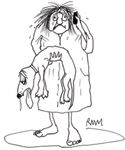Press 9 to talk to a real person
Proper phone etiquette can help guide owners through an emergency situation.
Pretend that you're the owner of a pet in an emergency situation. Panicked, you call the veterinary practice. A machine answers. You push buttons. A recorded voice puts you on hold while your pet's artery spurts or his eyeball prolapses. You listen to options, push buttons, and get placed on hold. You listen to music. It's probably not your kind of music. You hear a recorded message about dentistry, but it's never completed. Suddenly the dial tone is back.

Dr. Robert Miller
I have said for many decades that the phone is the single most important practice builder. An intelligent, well-trained, polite, and competent person should always answer the phone at a veterinary hospital. No recorded messages. No "push one," "push two," "push 11" instructions, no "We will answer momentarily," no lists of alternate phone numbers cited too rapidly for a distraught client to write them down.
Those who think they're saving money by not paying an employee or answering service to answer their phones don't understand how proper phone service can grow their practice. It grew my mom-and-pop rural house-call practice into a 12-doctor group by the time I retired. We answered the phone.
It was so simple at first. My wife or I answered the phone 24 hours a day. On my way back from a veterinary call in the country, I'd phone to see if any new calls had come in. If I stopped on the road to phone in, there were booths with hand-cranked telephones along Cornell and Las Virgenes roads. I cranked and a clear, polite voice said, "Number, puh-leeze?"

"Your call is very important to us. Please do not hang up. We will be with you momentarily. Meanwhile, have you heard about our pet food sale? Next week we ... bzzzzzz."
Eventually we got an answering service in town. I personally trained the operators. No, "VET-in-airy office" was not an acceptable greeting. I also told them that after hours were not just for emergencies and that I would speak to anybody if they had a problem, whether or not they were a client. As our practice grew we hired more people to answer the phone. We chose them carefully and added more and more phone lines.
My first business card listed my name, my profession, my address, and one phone number. It worked just fine. Today a business card lists one or more phone numbers, a cell phone number ("You're breaking up"), an e-mail address, a Web site, and a fax number. Regardless of which method a client uses to reach us, it's going to take much longer than it used to. Delays cause frustration, disappointment, and sometimes anger on the part of the caller. This is progress? This is how technology has improved our lives?
Answer the phone!
Dr. Robert Miller is an author, cartoonist, and speaker. He also writes a monthly column for Veterinary Medicine. Send your comments to ve@advanstar.com or post your thoughts on the message boards at dvm360.com.